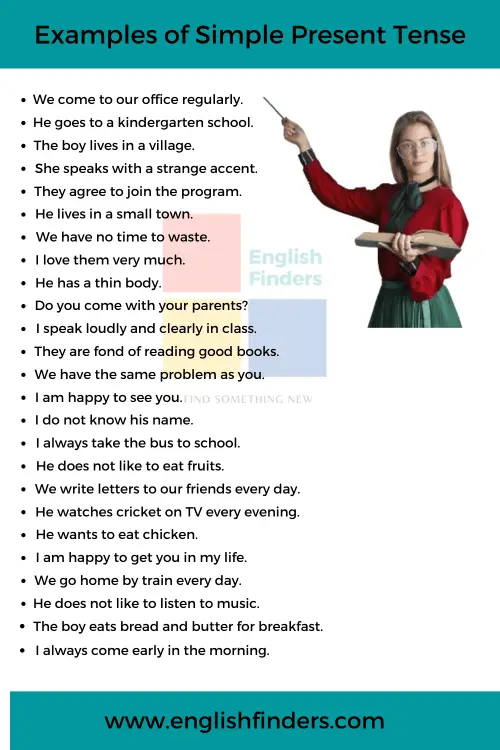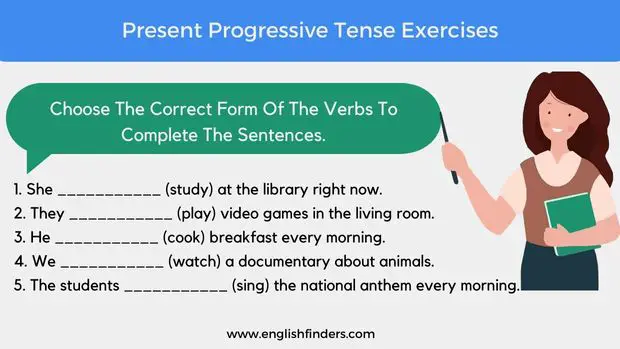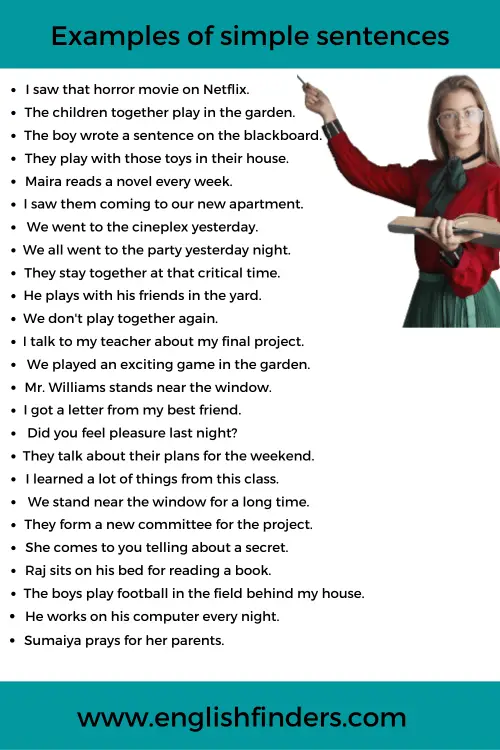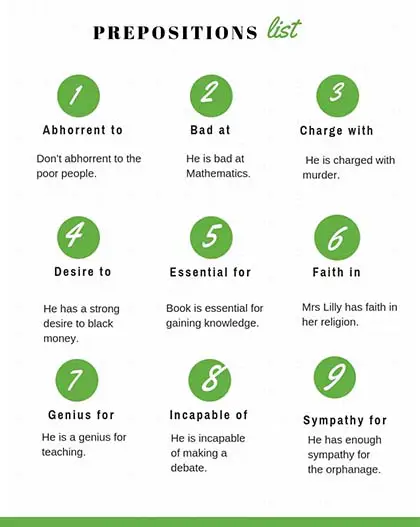Last updated on February 4th, 2025 at 09:20 pm
In this lesson, we will discuss the 50 useful examples of simple present tense. The simple present tense is one of the most commonly used tenses in English. We use it daily when discussing routines, facts, habits, or scheduled events. Simple Present Tense or Present Indefinite Tense indicates a present action or habitual fact. The third-person singular number has ‘s’ or ‘es’ at the end of its main verb. Let’s see some examples of the simple present tense:
- Rakin reads his favorite novel.
- Kane joins the party.
- She writes a letter to her friend.
- They join the navy.
- Do you make good food?
Structure: Subject+Verb(base form)+Object
Key Uses of Simple Present Tense
Quick Navigation
Daily Routines and Habits
We use the simple present tense to talk about actions that happen regularly or as part of a routine.
- I wake up at 6 AM every day.
- She drinks coffee in the morning.
- We go to school from Monday to Friday.
- He exercises three times a week.
- He goes to bed early on weekdays.
- They walk to school every morning.
- My mom cooks delicious meals.
- Rocky reads a book before sleeping.
- Emma writes in her journal every night.
- I drink water after every meal.
General Facts and Universal Truths
This tense is also used to express facts that are always true.
- Cows give us milk.
- The moon reflects sunlight.
- Birds migrate in winter.
- A square has four sides.
- The human body contains 206 bones.
- Snow melts in warm temperatures.
- Fire needs oxygen to burn.
- The internet connects people worldwide.
- Plants need sunlight to grow.
- Sound travels faster in water than in air.
Scheduled Events and Fixed Plans
Even though we usually use the present simple for habits, it is also used for schedules, especially for transportation, public events, and timetables.
- The bus arrives at 5:30 PM.
- The concert starts at 8 PM.
- The library opens at 9 AM.
- The train departs from platform 3.
- The restaurant serves lunch until 3 PM.
- The conference begins next Monday.
- The class starts at 10 AM every day.
- The new movie premieres next Friday.
- The museum offers free entry on Sundays.
- Our school closes for the holidays in December.
Instructions and Directions
We use the simple present tense to give clear instructions and directions.
- Close the door quietly.
- Do not touch the hot pan.
- Follow the signs to the exit.
- Wash your hands before eating.
- Mix the ingredients well before baking.
- Turn off the lights when you leave.
- Walk straight and cross the road at the signal.
- Insert the card into the slot to start the machine.
- Pour the milk into the glass carefully.
- Take the second left after the supermarket.
Feelings, Thoughts, and Opinions
This tense helps us express emotions, thoughts, and beliefs.
- I enjoy listening to music.
- She dislikes spicy food.
- We admire hard-working people.
- He hopes to visit Japan someday.
- They appreciate your help.
- My brother fears snakes.
- Sarah hates waking up early.
- The teacher believes in her students.
- My dad prefers tea over coffee.
- The little boy dreams of becoming an astronaut.
50 Examples of Simple Present Tense
Now it’s time to see the 50 useful examples of the simple present tense:
- We come to our office regularly.
- He goes to a kindergarten school.
- The boy lives in a village.
- She speaks with a strange accent.
- They agree to join the program.
- He lives in a small town.
- We have no time to waste.
- I love them very much.
- He has a thin body.
- Do you come with your parents?
- They are fond of reading good books.
- They do not like the poor people to suffer.
- We have the same problem as you.
- I am happy to see you.
- I do not know his name.
- They live in a small house.
- I always take the bus to school.
- They do not do their homework.
- He does not like to eat fruits.
- We write letters to our friends every day.
- He watches cricket on TV every evening.
- He wants to eat chicken.
- I am happy to get you in my life.
- We go home by train every day.
- The boy swims in the river.
- She looks out of the window.
- My brother sits next to me.
- He does not like to listen to music.
- Does he work in a bank?
- I do not remember his name.
- You do not understand my point.
- They live in a big house.
- The boy eats bread and butter for breakfast.
- I always wear a tie when I go to work.
- They do not like to play tennis.
- I always come early in the morning.
- She never comes on time.
- I speak loudly and clearly in class.
- They do not arrive on time.
- He works hard at school.
- Do you love to watch the football match?
- She does not come early in the morning.
- We do not speak loudly and clearly in class.
- Does he sing well?
- They take a bus every day to go to school.
- He speaks with an Italian accent.
- I play tennis every day after school.
- I watch a movie when I come home from my office.
- He does not come early in the morning.
- They listen to music when they come home from work.
Final Thoughts
The simple present tense is an essential part of English, helping us describe daily routines, facts, schedules, instructions, feelings, and opinions with ease. In this article, we covered its key uses and provided 50 useful examples to help you understand how it works in real-life situations. The best way to improve is through practice—try using simple present tense sentences in your daily speech and writing!
FAQs
When do we use the simple present tense?
We use the simple present tense to describe habits, routines, general facts, scheduled events, instructions, and feelings. For example: She drinks tea every morning.
How do we form the simple present tense?
For most verbs, we use the base form (e.g., I play, you play, they play). For third-person singular (he, she, it), we add -s or -es (e.g., He plays, she watches).
What are common mistakes with the simple present tense?
A common mistake is forgetting the -s or -es for third-person singular. For example, incorrect: She go to school. Correct: She goes to school.

Azizul Hakim is the founder & CEO of englishfinders.com. He is a passionate writer, English instructor, and content creator. He has completed his graduation and post-graduation in English language and literature.




